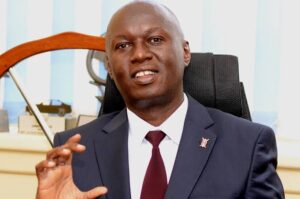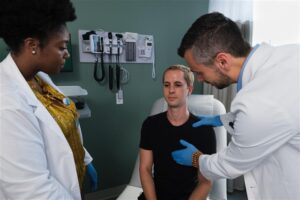Post-Pandemic upshot to Persons with Disabilities

By Benard Mulwa
Gaps continue to persist, hindering the realisation of full disability inclusion, particularly in Africa it has been revealed.
Secretary to the Cabinet, Mrs. Mercy Wanjau, said today during the launch of the Pre-Global Disability Summit (African Region)
As we navigate the evolving landscape, we are tasked with
rethinking our approach to inclusivity and development, ensuring that the needs and rights of persons with disabilities are at the forefront of both our policy and humanitarian efforts.
By prioritizing accessibility and equity in our post-pandemic recovery, we can forge a more inclusive Africa where every person, regardless of ability, has the opportunity to thrive and contribute meaningfully to our shared future.
In Kenya, the commitment to disability inclusion as a cornerstone of sustainable development is embedded in our Constitution, Vision 2030, and the Medium-Term Plan IV (2023-2027).
According to the 2019 census, 2.2% (0.9 million people) of Kenyans live with some form of disability. The Government of Kenya recognizes that disability inclusion is a prerequisite to the
achievement of the Sustainable Development Goals under Agenda 2023 and its central pledge to leave no one behind.
To this end, the government is striving to ensure, that Persons with Disabilities are accounted for and can participate equally in every aspect of life. This is instrumental in enhancing equal opportunity, inclusion, justice and economic growth for our country.
Looking beyond Kenya, the World Health Organization estimates that approximately 1.3 billion people worldwide live with a disability, with 80% residing in the Global South. In Sub-Saharan Africa, where poverty and inequality are particularly pronounced, people with disabilities face heightened risks of exclusion, which manifests as follows: –
Disability prevalence is notably higher in rural areas compared to urban settings.
Women experience higher rates of disability than men, driven by pre-existing barriers to rights and protections, risks associated with pregnancy and childbirth, and exposure to gender-based violence.
Persons with disabilities face lower levels of educational attainment due to inadequate resources and support in
schools, leading many to exit the formal education system prematurely.
Employment opportunities for persons with disabilities are severely limited. Discriminatory attitudes and a lack of accommodations by employers are significant barriers to their participation in the labor market.
Admittedly, nations worldwide including African nations, have made some progress in advancing inclusive development and ensuring equitable opportunities for all, including Persons Living with Disabilities. However, we are not quite there yet. Despite the progress made, gaps continue to persist, hindering the realisation of full disability inclusion, particularly in Africa.
we must move from commitments to action.
Today, I would like to focus on one of the key pillars to inclusion of persons with disability; technology. People with disabilities often face numerous challenges when accessing the internet and other digital platforms. This information gap can be detrimental and limits their ability to participate fully in the digital world.
By leveraging technology, we can make a profound difference.
For example, assistive technologies like screen readers and speech-to-text software are making information more accessible, while communication tools such as video calls with sign language interpretation are bridging gaps.
Online learning platforms are offering flexible educational opportunities, and job search websites are being designed to accommodate various needs, helping individuals find and thrive in employment.
In essence, technology is breaking down barriers, making the world more accessible and inclusive for everyone.
While the use of this kind of technology is not commonplace in Africa, we must hasten our pace in leveraging on their use in order to walk the development journey while carrying each and every single person along. This is an opportunity to rewrite our story.
Kenya, which stands as a prominent digital and economic centre in Eastern Africa, is focused on integrating a lot more technology into government operations. The 5th Administration has particularly identified digital transformation as one of its core pillars in enhancing service delivery to all of its citizens. Through progressive digitization, we are working towards ensuring safe, secure and efficient services where no one is left behind.
I am honored to serve as the Chair of the e-Citizen Implementation Committee, a role that brings together representatives from various Portfolio Ministries in a whole of government approach. The e-Citizen platform, which hosts approximately 21,000 services offered by different Ministries, Departments, and Agencies, is central to our mission of enhancing citizen engagement.
In 2023, we conducted a comprehensive accessibility audit of this platform to ensure it meets the highest standards of inclusivity. We have already begun implementing key recommendations, starting with improved color contrast.
Furthermore, we have urged the ICT Authority of Kenya to work towards ensuring that all government websites are fully accessible to persons with disabilities. This commitment reflects our dedication to making digital services equitable and inclusive for all citizens.
Over and above the work we are doing at e-Citizen, there are a number of mechanisms to bridge the digital exclusion gap. These include providing affordable access to technology, awareness creation and developing digital content that is relevant to people’s lives and context. Accessibility audit of web platforms should be done regularly so that it remains effective, and compliant while providing inclusive user experience. Overcoming digital exclusion is essential to ensuring that everyone has the opportunity to participate in the digital age.
The benefits of digital inclusion are clear. It promotes social inclusion, enhances educational opportunities, and improves employment prospects for people with disabilities. It also enhances their overall quality of life.
As I conclude, I wish to challenge each of us to become champions of digital inclusion. Let us not only advocate for
accessible technology but also actively work to implement and support solutions that remove barriers and empower everyone.
By embracing this responsibility, we can ensure that the digital world is a space where every individual, regardless of ability, can participate fully and equally. Together, we have the power to transform our commitment into tangible change and create a more inclusive future for all.





